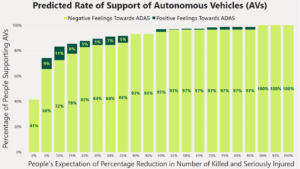New research from future mobility experts DG Cities has uncovered a significant trust gap in Advanced Driver Assistance Systems (ADAS) that could undermine the UK’s transition to autonomous vehicles (AVs).
The findings suggest there is widespread confusion about the capabilities and limitations of ADAS systems, creating safety concerns and eroding public confidence. DG Cities is now calling for improvements in testing, stricter regulations and better public communication to increase road safety and accelerate the pathway to an autonomous future.
“If people don’t understand or trust ADAS today, we cannot expect them to embrace autonomous vehicles tomorrow,” said Balazs Csuvar, director of innovation and net zero at DG Cities. “ADAS technologies are the stepping stones to full autonomy. The UK’s transition to a self-driving future relies on building public trust and confidence in these systems. Government and regulators need to act now to remove this critical barrier to AV adoption.”
ADAS technologies, such as Emergency Lane Keep Assist, Autonomous Emergency Braking, and Intelligent Speed Assist, are already commonplace and became mandatory in new vehicles in the EU in July 2024 under the updated General Safety Regulation (GSR2). However, the UK has yet to adopt GSR2, leaving oversight and standardization lagging, DG Cities noted.
Public confusion and lack of trust in ADAS
New research based on a representative UK survey by DG Cities reveals that while 70% of ADAS users appreciate the benefits, over 40% feel they were not given enough information about the systems at the point of purchase. This leads to dissatisfaction with ADAS features and impacts the accelerated adoption of AVs in the future. The data suggests that people who use ADAS features and feel positively toward them are almost twice as likely to use AVs as those who do not use or do not like them.

Meanwhile, a mystery shopping investigation found that UK dealership sales agents often lacked knowledge about ADAS features, or even exaggerated their capabilities, leading to confusion and potential safety risks.
“It is estimated that there will be a 30% reduction in crashes once all vehicles have ADAS features, which is very encouraging news,” Csuvar continued. “But this safety benefit could be undermined if drivers don’t understand how to use these systems properly, or when the systems themselves aren’t thoroughly tested against real-world scenarios.”
The impact on emergency services
Another key finding of the report highlighted that ADAS features are not rigorously tested for real-world conditions, particularly when it comes to the operations of the emergency services. DG Cities interviewed UK ambulance, fire, and police services and revealed serious issues.
For example, Lane Keep Assist interferes with emergency maneuvers by resisting center-line crossing, and automated emergency braking can be unexpectedly activated, disrupting response times.

“Currently, manufacturers are not required to pass thorough mandatory regulatory ADAS tests to sell vehicles in the UK,” said Csuvar. “Consumers and fleet operators must rely on non-compulsory Euro NCAP ratings to assess and compare ADAS performance. However, this requires participation from the manufacturer and the test scenarios the vehicle is subjected to are limited. Testing must be expanded to cover more scenarios and real-world edge cases, such as those involving emergency vehicles.”
Public support of AVs hinges on safety
DG Cities research shows that over half the UK public want an independent regulator or government entity to oversee AV safety, with only 30% trusting manufacturers to self-assess. The Automated Vehicles Act 2024 introduces the concept of AVs meeting the standard of a ‘careful and competent human driver,’ but public confidence will depend on clear, evidence-based assurances of safety.
The research finds that reducing serious injuries and fatalities is a very effective way to boost public support. Notably, when participants were asked if they would support widespread AV adoption on the condition that it reduced the number or severity of serious injuries and fatalities by just 5% from current levels, support increased from under half to nearly three-quarters.

DeepSafe calls for better testing, regulation and communication
The research by DG Cities has been conducted as part of DeepSafe, a consortium-led project aiming to advance the commercialization and deployment of self-driving vehicles. It is made up of transport and technology specialists, including DG Cities, dRisk.ai, Imperial College London, Claytex and rFpro. The research was funded by the Centre for Connected and Autonomous Vehicles (CCAV) via Innovate UK.
The consortium has integrated cutting-edge technologies to create test and development tools for automated vehicle technologies. These tools have been used to suggest new test protocols and build an extensive virtual library of edge case scenarios to subject ADAS and AV systems to. They found that testing on edge-cases using these methods has the potential of increasing the safety of AVs sixfold compared to some traditional methods used in the industry.
Based on the technical findings combined with the research on consumer attitudes, the consortium urges the UK government to take immediate action by developing comprehensive ADAS testing protocols to ensure safety before AVs are deployed; expanding testing to include edge cases, particularly those faced by emergency services; improving public communication with clear, open messaging about what ADAS and AVs can and cannot do; and involving the public in shaping standards to increase trust and transparency.
The research report, “Safety First? Understanding acceptance of automated vehicles”, is available to download from DG Cities’ website here.





